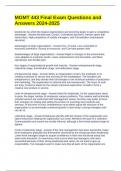Exam (elaborations)
MGMT 443 Final Exam Questions and Answers
- Course
- Institution
tendencies by which the largest organizations are becoming larger to gain a competitive advantage - Answer-Bureaucratic Control, Centralized decisions, Narrow spans (tall hierarchies), High proportions of middle managers, and Formalization (mechanistic structure) advantages of large organization...
[Show more]



